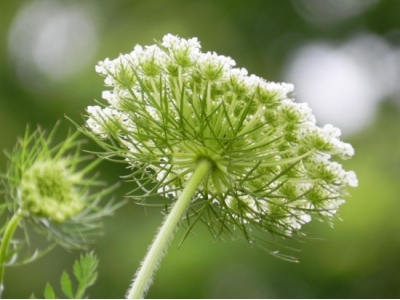How to Grow Queen Annes Lace

Are you looking for a touch of classic beauty to add to your garden or landscape? You might consider Queen Anne's Lace (Daucus Carota). This delicate, timeless biennial brings a vintage feel that can only be described as genteel.
Named after the exquisite embroidering virtuosity of Queen Anne of England, this plant lives up to its name. With wide, lacey, clustered flowers and ferny green foliage, the plant, and especially the flowers, have the dainty appearance of lace. It grows to be about 6 feet tall and 6 feet wide. Queen Anne's Lace is the darling of the garden.
As a distinguishing feature, most of the clusters of the light colored flowers have a deep red or black flower in the center. According to legend, this single dark flower represents a drop of blood shed by Queen Anne herself when she pricked her finger on a needle. This tiny distinctive flower is a fascinating feature for the young and old!
Queen Anne's Lace is native to temperate portions of Europe and southwestern Asia. It hasn't always been revered only for its looks. It is also known as wild carrot, and its fragrance and flavor resembles that of your garden variety carrot. High in Vitamin A, beta carotene and sugar, the roots, flowers and foliage have all been used throughout history as a source of food and medicine. Even today, some use the roots as a flavoring for tea and the flowers for tossed salads.
How to Grow and Care for Queen Anne's Lace
Queen Anne's Lace behaves a lot like a wildflower. It is easily grown from seed. It enjoys full sun and average quality but well draining soil. It will not tolerate freezing temperatures, so wait until the last frost of the season has passed to plant your Queen Anne's Lace seeds. Or plant them in the fall where the seeds will lie dormant until things warm up in the spring.
Simply spread your seeds over the ground where you'd like your Queen Anne's Lace to grow. Then, leave them alone. This low maintenance plant will produce a lot of foliage during its first year. Its second year will be the year for the flowers. These flowers will attract beneficial insects to your garden.
During its second growing season, as your Queen Anne's Lace matures, the plant will produce flowers in all of their varying stages- new and old- at the same time. As the flower clusters die off and turn to seed, the cluster will curl upward. It will look like a little basket.
The self made basket holds the seeds. The seeds will eventually drop to the ground, and if they land on watered soil, they will begin a new life cycle. You can also harvest the seeds yourself from the little basket. You can plan on enjoying your Queen Anne's Lace for years with its self seeding abilities.
If you would like to prevent the spread of your Queen Anne's Lace, remove the baskets of seeds and dispose of them thoughtfully.
Queen Anne's Lace Pests and Problems
Queen Anne's Lace is a prolific self seeder. So, before you grow Queen Anne's Lace, check with your local extension office. In many areas here in the U.S., Queen Anne's Lace is considered a noxious weed or an invasive species. It spreads very quickly and prefers the warm, humid conditions of its native lands. So, if you live in a warm and muggy region, be extra careful.
Also, if you are considering ingesting your Queen Anne's Lace, be doubly certain that you have grown Queen Anne's Lace and not it's evil look alike- poison hemlock. The difference between the two plants is that Queen Anne's Lace has a hairy stem whereas poison hemlock has a smooth stem. Poison hemlock smells bad, too. Queen Anne's Lace smells sweet. The video below gives more detail on how to identify Queen Anne's Lace.
In general, Queen Anne's lace is a tough plant that isn't often affected by bugs or disease. However, you might have to look out for some of the pests and diseases that are common to plants growing in hot and humid conditions. Give your Queen Anne's Lace enough elbow room to ensure plenty of sunshine and good circulation. Your plant will likely remain healthy and stout in spite of a few bugs.
Related news
 Common Diseases of Orange Trees
Common Diseases of Orange Trees When properly planted and cared for, orange trees don’t suffer a lot of disease or insect problems.
 How to Grow Periwinkle (Vinca)
How to Grow Periwinkle (Vinca) Common periwinkle (Vinca minor) is an ideal plant for tough spots. It is also called lesser periwinkle or creeping myrtle.
 How to Grow Acacia Tree
How to Grow Acacia Tree Native to subtropical regions throughout the world, the acacia trees grow in the harshest climates. Acacia trees (Acacia spp.) can be found in the African savan